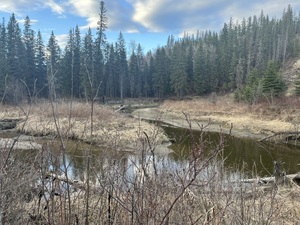
Live stream: mobile_amiskwaciywaskahikan.mp3
amiskwaciy-wâskahikan (Edmonton, Alberta, Canada)
Leslie Sharpe
Latitude: +53.49872°
Longitude: -113.56012°
Streaming from a forest above a beaver lodge in Whitemud Ravine Nature Reserve, amiskwacîwâskahikan / Edmonton, Métis Nation of Alberta Region 4. Listening for water, beaver tail slaps, mergansers, Canada geese, woodpeckers, Black-capped Chickadee, coyotes, red squirrels, urban traffic in distance. Streamed by Leslie Sharpe with Dougal MacDonald.
waskawâkamipayiw beats
The stream will play from civil twilight (5.12am MDT) until 6.15am MDT (UTC -6).
The stream will play from civil twilight (5.12am MDT) until 6.15am MDT (UTC -6).
Listening to the land supports land acknowledgement – first of the Indigenous peoples who have lived and passed through here since long before colonial settlement, and second of the other lifeforms in this place. We’re streaming from Whitemud Ravine Nature Reserve in Amiskwacî Wâskahikan (Beaver Hills House in Cree, so-called Edmonton), right next to the urban Indigenous cultural site “kihcihkaw askî,” which means "this place here is sacred land" in the Cree language. The Nahiawuk Cree lived here along the confluence of Whitemud Creek and the North Saskatchewan River and continue to call this place home, with many other first nations and Métis people.
Waskawâkamipayiw – The water is moving (around a beaver lodge). Whitemud Ravine Nature Reserve along Whitemud Creek has the highest biodiversity of plants and animals in the city, and is a home or stopping point for beaver, coyotes, deer, and numerous migrating and resident birds. Beaver move through this urban forest to find food and lodging material, often falling and dragging large trees in a mixed woodland of pine, willow, poplar, birch and aspen. As you walk through the reserve trails, you will see gnawed trees with protective wire wrapped around to prevent them from being chewed further and falling onto the trails.
Beaver are a keystone species and create wetland habitats important to other species in this area. Beaver dams and ponds gather flood water to create deep waters. These control surface water flow during flood events caused by extreme weather shifts common to climate change, reducing erosion and maintaining surface ecosystems. The ponds also filter water that flows downstream. Numerous species of plants and animals benefit from this ecosystem.
Waskawâkamipayiw Beats: Beavers are survivors, builders, and tooth-tail jammers.
Settler colonialism created severe declines of beaver populations with excessive fur-trade trapping, and beaver habitat destruction through land development. In Alberta, threats to animal habitats and indigenous ways of life continue through extractive economies, climate change denial, and lack of indigenous consultation on policy and land use. Beavers defy this history as they build community, find places to dam, habitats to revive, water to jam-slap their tails and trees to chatter-bite. If we’re lucky we’ll hear their beats. Listen, with elbows up!
Settler colonialism created severe declines of beaver populations with excessive fur-trade trapping, and beaver habitat destruction through land development. In Alberta, threats to animal habitats and indigenous ways of life continue through extractive economies, climate change denial, and lack of indigenous consultation on policy and land use. Beavers defy this history as they build community, find places to dam, habitats to revive, water to jam-slap their tails and trees to chatter-bite. If we’re lucky we’ll hear their beats. Listen, with elbows up!